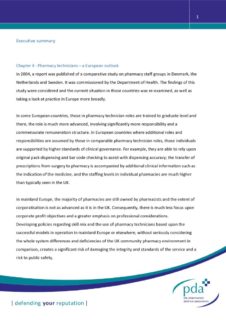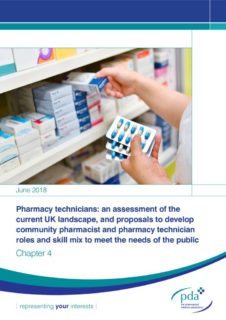It found that in some of these countries non-pharmacist staff worked to a high standard, undertook a significant amount of activity and in some cases enabled pharmacists to leave the community pharmacy to provide services elsewhere. These findings have been one of the drivers of the UK governments ambition to seek to rely on pharmacy technicians in the UK to drive remote supervision in community pharmacy.
However, the PDAs investigations, detailed in the fourth chapter of the report on the role of Pharmacy Technicians, have shown that community pharmacy support staff in many countries in the EU are degree qualified, are paid salaries commensurate to their roles and responsibilities and are working in community pharmacy environments that are much better resourced and which enjoy significantly better clinical governance arrangements than do their UK counterparts. In some of these countries, the education system is similar for both pharmacists and ‘prescriptionists’ until a certain point in the course when they choose to specialise in either being a pharmacy based ‘prescriptionist’ or a pharmacist involved in the wider local healthcare system.
Over and above the training standards, in European countries where additional roles and responsibilities are assumed by those in comparable pharmacy technician roles in community pharmacy, those individuals are supported by much higher standards of clinical governance. For example, they may be able to rely upon original pack dispensing and bar code checking to assist with dispensing accuracy. The transfer of prescriptions from surgery to pharmacy in some countries is accompanied by additional clinical information such as the indication of the medicine. Furthermore, not only is there a higher standard of staff training, but the staffing levels of both pharmacists and trained staff in individual pharmacies are much higher than typically seen in the UK.
Whilst these EU comparators provide a useful indicator of how UK community pharmacy could be improved in the future, it is inappropriate to use these EU examples to drive the UK governments ambition for remote supervision without a detailed consideration of these important differences.
The PDA makes several recommendations;
- The successful community pharmacy skill mix models of Europe could only be used as a realistic template for the UK, when whole-system improvement to the community pharmacy operation in the UK is also undertaken. This would include:
-
- Increasing the educational standard of UK pharmacy technicians (it was previously recommended that it becomes a level 4 educational standard (sub degree level) in section 3)
- Introducing a clinical career framework for community pharmacists and pharmacy technicians, and subsequently increasing the salaries of pharmacy technicians
- Ensuring that pharmacies are better staffed, with more than one pharmacist and a complement of trained, registered pharmacy technicians
- Improving the clinical governance arrangements within the community pharmacy setting, enabling pharmacists to rely on clinical indications, barcode checking, original pack dispensing and access to the full electronic patient records on a read and write basis.
- The ability for pharmacists to work with professional autonomy even in pharmacies that are owned by large corporate multiples.
- If patient safety and role development of pharmacists and pharmacy technicians is to be a serious proposition in the UK, then such measures should be introduced as soon as possible. Such improved clinical governance and wider system enhancements would provide a much more robust springboard to enhance the roles of pharmacists and pharmacy technicians. Without this, the development of skill mix in the community pharmacy setting can only be very limited.
Download a summary of the fourth chapter here
Download the full fourth chapter here
NOTE TO EDITORS
About the PDA
The PDA (Pharmacists’ Defence Association) is a not-for-profit organisation, which aims to act upon and support the needs of individual pharmacists and pharmacy students and, when necessary, defend their reputation. All PDA members are entitled to free PDA Union membership.
The PDA Union is the only trade union in the UK exclusively for pharmacists. It has a certificate of independence and is a member of Unions21 and EPhEU. The PDA and the PDA Union have more than 28,000 members.
Press enquiries
For press enquiries, please contact the communications department on:
T: +44 (0)121 694 7000
E: press@the-pda.org
W: www.the-pda.org

